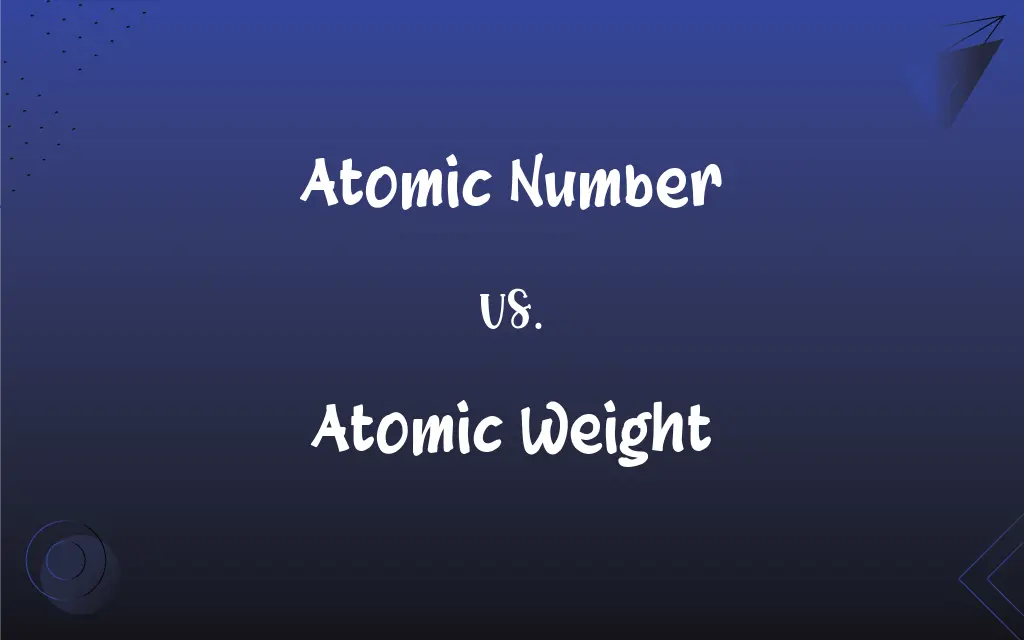Atomic Number vs. Atomic Weight: What's the Difference?
Edited by Harlon Moss || By Janet White || Published on January 28, 2024
Atomic number is the count of protons in an atom's nucleus, defining the element type, while atomic weight is the average mass of an atom of an element, considering its isotopes.

Key Differences
Atomic number is a fundamental property of elements, representing the number of protons in the nucleus of an atom. It uniquely identifies an element in the periodic table. For example, hydrogen has an atomic number of 1. Atomic weight, on the other hand, is a measure of the average mass of atoms of an element, calculated by taking into account the relative abundance of its isotopes.
The atomic number determines the chemical properties of an element and its place in the periodic table. Elements are arranged in the periodic table in ascending order of their atomic numbers. In contrast, atomic weight reflects the mass aspect of an element, considering the natural occurrence of its various isotopes, each with a slightly different mass.
Atomic number is always a whole number and is specific to each element. For instance, carbon always has an atomic number of 6. However, atomic weight is usually a decimal number because it is a weighted average of the isotopic masses of an element's naturally occurring isotopes.
Changes in the atomic number of an atom would result in a change of the element itself. For example, removing one proton from nitrogen (atomic number 7) would turn it into carbon (atomic number 6). Atomic weight can vary slightly between different samples of an element due to variations in isotopic composition, but it does not change the fundamental nature of the element.
In summary, the atomic number is key to identifying and defining an element, and it affects the element's position in the periodic table and its chemical behavior. The atomic weight, while also important, gives information about the average mass of the element's atoms, influenced by the distribution of its isotopes.
ADVERTISEMENT
Comparison Chart
Definition
Number of protons in an atom's nucleus
Average mass of an atom of an element
Representation
Always a whole number
Usually a decimal number
Role in Periodic Table
Determines element's position
Does not determine position
Effect on Element Identity
Changing it changes the element
Variation does not change the element
Variability
Constant for each element
Varies based on isotopic abundance
ADVERTISEMENT
Example Element
Oxygen has an atomic number of 8
Oxygen's atomic weight is approximately 16
Influence on Properties
Defines chemical properties
Reflects mass, not chemical behavior
Importance in Chemistry
Crucial for element identification
Important for understanding atomic mass
Relation to Isotopes
Same for all isotopes of an element
Varies due to isotopic composition
Calculation
Count of protons
Weighted average of isotope masses
Atomic Number and Atomic Weight Definitions
Atomic Number
Determines the element's position in the periodic table.
An element with atomic number 3 is lithium.
Atomic Weight
Reflects the mass of an element's most common isotopes.
The atomic weight of hydrogen includes contributions from its isotopes.
Atomic Number
Key to an element's chemical properties.
Changing the atomic number alters the element's identity.
Atomic Weight
Calculated based on the relative abundance of isotopes.
The atomic weight of chlorine varies due to its isotopes.
Atomic Number
A unique identifier for each chemical element.
Elements are arranged by their atomic number in the periodic table.
Atomic Weight
Important for understanding atomic mass in chemistry.
Atomic weight is vital for calculating molecular weights in reactions.
Atomic Number
A whole number representing protons in an atom.
The atomic number of carbon is 6, differentiating it from other elements.
Atomic Weight
A decimal number representing an element's average atomic mass.
Oxygen has an atomic weight of about 16, reflecting its isotopic distribution.
Atomic Number
The number of protons in the nucleus of an atom.
The atomic number of helium is 2, indicating it has two protons.
Atomic Weight
The average mass of atoms of an element.
The atomic weight of carbon is approximately 12.01.
FAQs
Are atomic number and atomic weight the same?
No, they are different properties; atomic number is about protons, atomic weight about mass.
Can atomic number change for an element?
No, changing the atomic number changes the element itself.
What is an atomic number?
It's the number of protons in an atom's nucleus, unique to each element.
What does atomic weight represent?
Atomic weight represents the average mass of an element's atoms, considering its isotopes.
Why is atomic weight usually a decimal?
Because it's a weighted average of the isotopic masses.
How is atomic number used in the periodic table?
It determines the element's position in the periodic table.
Does atomic weight affect chemical properties?
Not directly; it's more about the mass of the element.
Do isotopes of an element have different atomic numbers?
No, isotopes have the same atomic number but different numbers of neutrons.
Does atomic weight vary for the same element?
Yes, it can vary slightly due to different isotopic compositions.
What happens if you change an atom's atomic number?
You get a different chemical element.
Why does atomic weight matter in chemistry?
It helps in understanding the mass of molecules and stoichiometry in reactions.
Do electrons contribute to atomic number?
No, atomic number is solely based on protons.
Is the atomic number a decimal?
No, it's always a whole number.
Can two elements have the same atomic number?
No, each element has a unique atomic number.
How does atomic weight relate to isotopes?
It's a weighted average of the masses of an element's isotopes.
Why are atomic number and weight fundamental in chemistry?
They help identify elements and understand their physical and chemical properties.
Is atomic weight constant across all samples of an element?
It can vary slightly depending on isotopic distribution.
Is atomic weight important in chemical reactions?
Yes, especially for calculating molecular weights and proportions.
Does the atomic number change in chemical reactions?
No, chemical reactions involve electrons, not changes in the nucleus.
How do you find an element's atomic number?
It's equal to the number of protons in its nucleus.
About Author
Written by
Janet WhiteJanet White has been an esteemed writer and blogger for Difference Wiki. Holding a Master's degree in Science and Medical Journalism from the prestigious Boston University, she has consistently demonstrated her expertise and passion for her field. When she's not immersed in her work, Janet relishes her time exercising, delving into a good book, and cherishing moments with friends and family.
Edited by
Harlon MossHarlon is a seasoned quality moderator and accomplished content writer for Difference Wiki. An alumnus of the prestigious University of California, he earned his degree in Computer Science. Leveraging his academic background, Harlon brings a meticulous and informed perspective to his work, ensuring content accuracy and excellence.































































